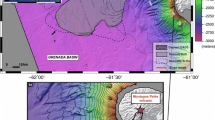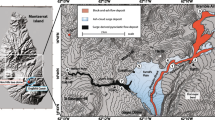Abstract
Many major volcanic flank collapses involve the failure of low-angle strata in or under the edifice. Such failures produce voluminous, destructive debris avalanches that are a major volcanic hazard. At Socompa, Las Isletas-Mombacho and Parinacota volcanoes, field studies have shown that during catastrophic flank collapse a significant segment of their substrata was detached and expelled from beneath the volcanic edifice and formed a mobile basal layer on which the sliding flanks were transported. Previous studies have proposed that gravitational flank spreading was likely involved in the onset of sudden substrata failure. The early stages of this particular type of flank collapse can be modelled under laboratory conditions using analogue models. This allows us to study the development of structures accommodating early deformation of the sliding flank during catastrophic collapse. In the experiments, the detached substratum segment (low-viscosity basal layer) was modelled with a silicone layer, and the overlying stratovolcano with a layered sand cone. The first structure developed in the models is a graben rooted in the low-viscosity basal layer. This graben forms the limits of the future avalanche-amphitheatre and divides the sliding flank into a ‘toreva’ domain (upper sliding flank) and a ‘hummock’ domain (lower sliding flank). These domains display distinctive structural patterns and kinetic behaviour. Normal faults develop in the toreva domain and inside the graben, while the hummock domain is characterised by transtensional structures. The hummock domain also over-thrusts the lower amphitheatre sides, which allows subsequent sideways avalanche spreading. Measurements show that horizontal speeds of the hummock domain are always higher than that of the toreva domain during model collapse. The main role played by the low-viscosity basal layer during this type of collapse is to control the size, shape and structural complexity of the sliding flank; it also transmits mass and momentum from the toreva to the hummock domain.












Similar content being viewed by others
References
Acocella V (2005) Modes of sector collapse of volcanic cones: Insights from analogue experiments. J Geophys Res 110:B02205. doi:10.1029/2004JB003166
Afrouz AA (1992) Practical handbook of rock mass classification systems and modes of ground failure. CRC, London
Ando M (1979) The Hawaii earthquake of November 29, 1975: low dip angle faulting due to forceful injection of magma. J Geophys Res 84:7616–7626
Bell FG (2000) Engineering properties of soils and rocks, 4th edn. Blackwell, Oxford
Borgia A (1994) Dynamic basis for volcanic spreading. J Geophys Res 99:17, 791-17,804
Borgia A, Ferrari L, Pasquaré G (1992) Importance of gravitational spreading in the tectonic and volcanic evolution of Mt. Etna Nature 357:231–235
Borgia A, Tizzani P, Solaro G, Manzo M, Casu F, Luongo G, Pepe A, Bernardino P, Fornaro G, Sansosti E, Ricciardi GP, Fusi N, Di Donna G, Lanari R (2005) Volcanic spreading of Vesuvius, a new paradigm for interpreting its volcanic activity. Geophys Res Lett 32:L03303. doi:10.1029/2004GL022155
Carracedo JC, Day SJ, Guillou H, Perez Torrado FJ (1999) Giant Quaternary landslides in the evolution of La Palma and El Hierro, Canary Islands. J Volcanol Geotherm Res 94:169–190
Clavero JE, Sparks RSJ, Huppert HE, Dade WB (2002) Geological constraints on the emplacement mechanism of the Parinacota debris avalanche, Northern Chile. Bull Volcanol 64:40–54
Dade WB, Huppert HE (1998) Long-runout rockfalls. Geology 26:803–806
Delcamp A, van Wyk de Vries B, James M (2008) The influence of edifice slope and substrata on volcano spreading. J Volcanol Geotherm Res 177:925–943
Donnadieu F, Merle O (1998) Experiments on the indentation process during cryptodome intrusions: New insights into Mount St. Helens deformation. Geology 26:79–82
Elsworth D, Voight B (1996) Evaluation of volcano flank instability triggered by dike intrusion. In: McGuire WJ, Jones AP, Neuberg J (eds) Volcano instability on the Earth and other planets. Geol Soc London Spec Pub 110:45–53
Gorshkov GS (1959) Gigantic eruption of Volcano Bezymianny. Bull Volcanol 20:77–109
Hubbert MK (1937) Theory of scale models as applied to the study of geologic structrures. Geol Soc Am Bull 48:1459–1520
Kelfoun K, Druitt TH (2005) Numerical modeling of the emplacement of Socompa rock avalanche, Chile. J Geophys Res 110:B12202. doi:10.1029/2005JB003758
Kelfoun K, Druitt TH, van Wyk de Vries B, Guilbaud MN (2008) Topographic reflection of the Socompa debris avalanche, Chile. Bull Volcanol 70:1169–1187
Lagmay AMF, van Wyk de Vries B, Kerle N, Pyle DM (2000) Volcano instability induced by strike slip-faulting. Bull Volcanol 62:331–346
Lopez DL, Williams SN (1993) Catastrophic volcanic collapse. Relation to hydrothermal processes. Science 260:1, 794–1,796
Merle O, Borgia A (1996) Scaled experiments of volcanic spreading. J Geophys Res 101:13, 805–13,817
Montaldo A, Vinciguerra S, Menza Z, Patane G (1996) Recent seismicity of Mount Etna: implications for flank instability. In: McGuire WJ, Jones AP, Neuberg J (Eds) Volcano instability on the Earth and other planets. Geol Soc London Spec Pub 110:169–177
Moore JG, Clague DA, Holcomb RT, Lipman PW, Normark WR, Torresan ME (1989) Prodigious submarine landslides on the Hawaiian Ridge. J Geophys Res 94:465–17,484
Morgan JK, Moore JG, Clague DA (2003) Slope failure and volcanic spreading along the submarine south flank of Kilauea volcano, Hawaii. J Geophys Res 108:2415. doi:10.1029/2003JB002411
Oehler J-F, van Wyk de Vries B, Labazuy P, Lénat J-F (2004) Gravitational destabilization of oceanic shield volcanoes on Low Strength Layers (LSL): an analogue modeling approach. J Volcanol Geotherm Res 144:169–189
Reiche P (1937) The toreva-block—a distinctive landslide type. J Geol 45:538–548
Reid ME, Sisson TW, Brien DL (2001) Volcano collapse promoted by hydrothermal alteration and edifice shape, Mount Rainier, Washington. Geology 29:779–782
Shea T, van Wyk de Vries B (2008) Structural analysis and analogue modelling of the kinematics and dynamics of large-scale rock avalanches. Geosphere 4:657–686
Shea T, van Wyk de Vries B, Pilato M (2008) Emplacement mechanisms of contrasting debris avalanches at Volcán Mombacho (Nicaragua), provided by structural and facies analysis. Bull Volcanol 70:899–921
Siebert L (1984) Large volcanic debris avalanches: characteristics of source areas, deposits, and associated eruptions. J Volcanol Geotherm Res 22:163–197
Siebert L, Glicken H, Ui T (1987) Volcanic hazards form Bezymianny- and Bandai-type eruptions. Bull Volcanol 49:435–459
Sousa J, Voight B (1995) Multiple-pulsed debris avalanche emplacement at Mount St. Helens in 1980: Evidence from numerical continuum flow similations. J Volcanol Geotherm Res 66:227–250
Szakács A, Krézsek C (2006) Volcano-basement interaction in the Eastern Carpathians: Explaining unusual tectonic features in the Eastern Transylvanian basin, Romania. J Volcanol Geotherm Res 158:6–20
Tibaldi A (2001) Multiple sector collapses at Stromboli volcano, Italy: how they work. Bull Volcanol 63:112–125
Ui T (1983) Volcanic dry avalanche deposits—identification and comparison with non-volcanic debris stream deposits. J Volcanol Geotherm Res 18:135–150
van Bemellen RW (1949) The geology of Indonesia: general geology of Indonesia and adjacent archipelagoes. Government Printing Office, The Hague
van Wyk de Vries B, Borgia A (1996) The role of basement in volcano deformation. In: McGuire WJ, Jones AP, Neuberg J (eds) Volcano instability on the Earth and other planets. Geol Soc London Spec Pub 110:95–110
van Wyk de Vries B, Francis PW (1997) Catastrophic collapse at stratovolcanoes induced by gradual volcano spreading. Nature 387:387–390
van Wyk de Vries B, Kerle N, Petley D (2000) Sector collapse forming at Casita volcano, Nicaragua. Geology 28:167–170
van Wyk de Vries B, Matela R (1998) Styles of volcano-induced deformation: numerical models of substratum flexure, spreading and extrusion. J Volcanol Geotherm Res 81:1–18
van Wyk de Vries B, Self S, Francis PW, Keszthelyi L (2001) A gravitational spreading origin for the Socompa debris avalanche. J Volcanol Geotherm Res 105:225–247
Vidal N, Merle O (2000) Reactivation of basement faults beneath volcanoes: a new model of flank collapse. J Volcanol Geotherm Res 99:9–26
Voight B (1981) Time scale for the first moments of the May 18 eruption. In: Lipman PW, Mullineaux DR (eds) The 1980 eruptions of Mount St. Helens, Washington. US Geol Surv Prof Pap 1250:69–86
Voight B, Glicken H, Janda RJ, Douglass PM (1981) Catastrophic rockslide avalanche of May 18. In: Lipman PW, Mullineaux DR (eds) The 1980 eruption of Mount St. Helens, Washington. US Geol Surv Prof Pap 1250:347–377
Wadge G, Francis PW, Ramirez CF (1995) The Socompa collapse and avalanche event. J Volcanol Geotherm Res 66:309–336
Weijemars R, Schmeling H (1986) Scaling of Newtonian and non-Newtonian fluid dynamics without inertia for quantitative modeling of rock flow due to gravity (including the concept of rheological similarity). Phys Earth Planet Int 43:316–330
Williams DL, Abrams G, Finn C, Dzurisin D, Johnson DJ, Denlinger R (1987) Evidence from gravity data for an intrusive complex beneath Mount St. Helens. J Geophys Res 92:207–10,222
Wooller L, van Wyk de Vries B, Murray JB, Rymer H, Meyer S (2004) Volcano spreading controlled by dipping substrata. Geology 32:573–576
Acknowledgements
D. Andrade was supported by the Secretaría Nacional para la Ciencia y la Tecnología (SENACYT-Ecuador), the French Ministry of Foreign Affairs through the French Embassy in Ecuador, and the Institut de Recherche pour le Développement (IRD, France). We thank Benjamin Bernard, Alberto de la Fuente and the reviewers William Chadwick and Tim Davies for their critical remarks on the original manuscript.
Author information
Authors and Affiliations
Corresponding author
Additional information
Editorial responsibility S. Nakada
Rights and permissions
About this article
Cite this article
Andrade, S.D., van Wyk de Vries, B. Structural analysis of the early stages of catastrophic stratovolcano flank-collapse using analogue models. Bull Volcanol 72, 771–789 (2010). https://doi.org/10.1007/s00445-010-0363-x
Received:
Accepted:
Published:
Issue Date:
DOI: https://doi.org/10.1007/s00445-010-0363-x




